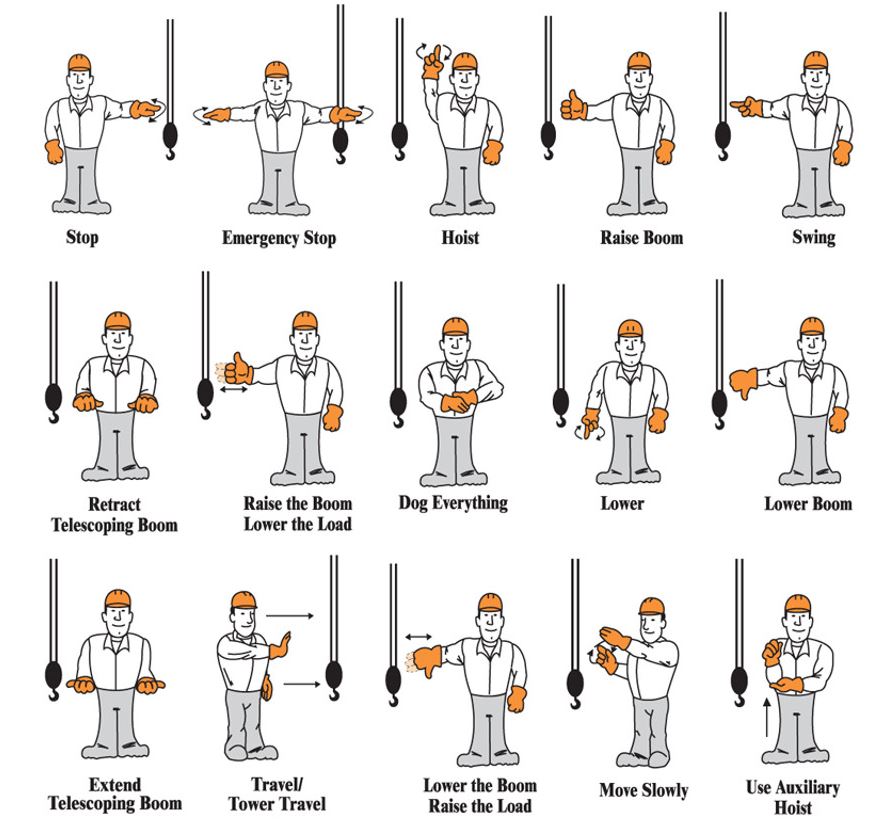Mastering Crane Signals in Lifting Operations
Mastering Crane Signals in Lifting Operations
In the complex world of rigging and lifting operations, communication is the lifeline that ensures safety, efficiency, and precision. Whether it’s the meticulous movement of heavy loads on construction sites or the delicate handling of equipment in industrial settings, effective communication signals are paramount. In this blog, we’ll delve into the importance of communication signals in rigging, focusing on common hand crane signals and other communication methods that form the backbone of safe and successful lifting operations. Understanding the Imperative of Crane Signals:
Within the dynamic and bustling environment of lifting operations, cranes play a pivotal role in the vertical dance of heavy loads. Efficient communication between crane operators and signal persons is imperative for the success and safety of every lift. This is where crane signals, often conveyed through precise hand gestures, emerge as the silent language that guides these mechanical giants.The Art of Non-Verbal Communication:
Verbal communication in the midst of the cacophony of a construction site or an industrial setting can be challenging. Crane operators, perched high in their cabs, rely heavily on non-verbal cues to understand the intricacies of each lift. Hand signals, with their standardized meanings, have become a universal language that transcends the noise and ensures seamless communication between the ground and the crane.Common Hand Signals in Crane Operations:
Hoist Load Signal:
Arm extended, fingers closed, and lifting upward. Instructs the crane operator to hoist the load.
Lower Load Signal:
Arm extended, fingers closed, and moving downward in a patting motion. Signals the crane operator to lower the load.
Extend Boom Signal:
One hand extended, palm down, and moving away from the body. Instructs the crane operator to extend the boom.
Raise boom:
Extend an arm horizontally to the side of the body and signal thumbs up with a closed fist.
Retract Boom Signal:
One hand extended, palm up, and moving toward the body.
Lower boom
In order to lower the boom, extend an arm horizontally and signal thumbs down with a closed fist.
Swing boom:
To swing the boom, extend an arm out horizontally, using index finger to point in the direction the boom is to swing.
Move slowly:
In order to slow the rate of an action, place hand above the hand that is giving the action signal.
Trolley Travel Signal:
Arm extended horizontally, hand in a fist, and moving in the direction of trolley travel. Guides the crane operator in moving the trolley horizontally.
Dog everything:
Clasp hands together, placing them at waist level. This signal will stop all activity.
Stop Signal:
Hand raised with the palm facing outward. It is universally understood as an immediate instruction to stop all crane operations.
Emergency Stop Signal:
Arms crossed above the head. Demands an immediate and complete stop of all crane operations due to an emergency.

Additional Communication Methods in Crane Operations:
Radio Communication:
- In situations where hand signals might be impractical, radio communication provides a direct and instant means for crane operators and signal persons to convey instructions.
- Operators and signal persons should be well-versed in interpreting load charts to ensure that the crane is operating within its safe working limits.
Written Lift Plans:
Comprehensive lift plans, including crane signals, should be documented and communicated to all involved parties before the lift begins. Training and Standardization: Just as in any language, fluency in crane signals requires training and standardization. Operators and signal persons must undergo rigorous training to ensure a shared understanding of each signal’s meaning. Standardized signals across the industry enhance communication and minimize the risk of misunderstandings.Challenges and Solutions:
Adverse weather conditions, limited visibility, or the complexity of the lift itself can pose challenges to effective communication in crane operations. Implementing additional safety measures, such as high-visibility clothing, signaling lights, or alternative communication methods, becomes essential in overcoming these challenges.
Conclusion:
——————————————————————————————————————————————
The Hercules Group of Companies encompasses a wide portfolio of products and services across 7 diverse companies.


